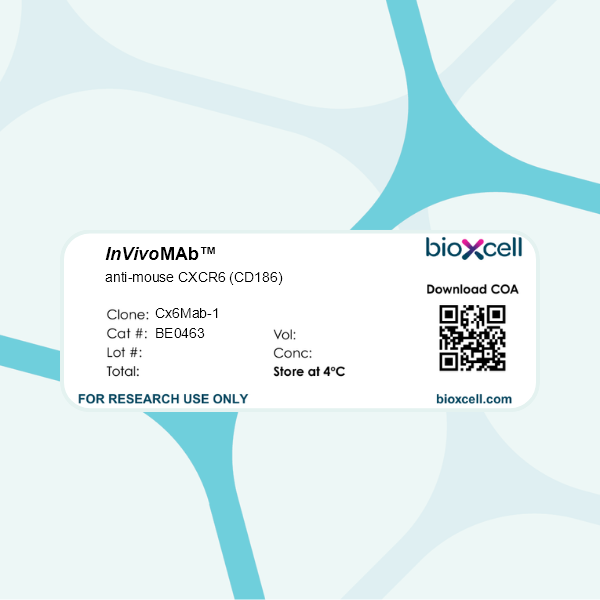InVivoMAb anti-mouse CXCR6 (CD186)
Product Description
Specifications
| Isotype | Rat IgG1, κ |
|---|---|
| Recommended Isotype Control(s) | InVivoMAb rat IgG1 isotype control, anti-horseradish peroxidase |
| Recommended Dilution Buffer | InVivoPure pH 7.0 Dilution Buffer |
| Immunogen | Synthetic peptide corresponding to the N-terminal extracellular region of mouse CXCR6 (AA 1-19) |
| Reported Applications |
Flow cytometry Western blotting ELISA For details on in vivo applications, please contact technicalservice@bioxcell.com |
| Formulation |
PBS, pH 7.0 Contains no stabilizers or preservatives |
| Endotoxin |
≤1EU/mg (≤0.001EU/μg) Determined by LAL assay |
| Purity |
≥95% Determined by SDS-PAGE |
| Sterility | 0.2 µm filtration |
| Production | Purified from cell culture supernatant in an animal-free facility |
| Purification | Protein G |
| Molecular Weight | 150 kDa |
| Storage | The antibody solution should be stored at the stock concentration at 4°C. Do not freeze. |
| Need a Custom Formulation? | See All Antibody Customization Options |
Application References
Flow Cytometry
Western Blot
Kitamura K, Suzuki H, Kaneko MK, Kato Y (2022). "Cx6Mab-1: A Novel Anti-Mouse CXCR6 Monoclonal Antibody Established by N-Terminal Peptide Immunization" Monoclon Antib Immunodiagn Immunother 41(3):133-141.
PubMed
The CXC chemokine receptor 6 (CXCR6) is a member of the G protein-coupled receptor family that is highly expressed in helper T type 1 cells, natural killer cells, cytotoxic T lymphocytes, and various type of cells in tumor microenvironment (TME). CXCR6 has been proposed as a therapeutic target against tumors through regulation of the tumor TME. In this study, we developed specific and sensitive monoclonal antibodies (mAbs) for mouse CXCR6 (mCXCR6), which are useful for flow cytometry and Western blotting by N-terminal peptide immunization into rat. The established anti-mCXCR6 mAb, Cx6Mab-1 (rat IgG1, kappa), reacted with not only mCXCR6-overexpressed Chinese hamster ovary-K1 (CHO/mCXCR6) but also mCXCR6-endogenously expressed cell lines, such as P388 (mouse lymphoid neoplasm) and J774-1 (mouse macrophage-like) through flow cytometry. Kinetic analyses using flow cytometry indicated that the dissociation constants (KD) of Cx6Mab-1 for CHO/mCXCR6, P388, and J774-1 cells were 1.7 × 10-9 M, 3.4 × 10-7 M, and 3.8 × 10-7 M, respectively. Furthermore, Cx6Mab-1 could detect endogenous mCXCR6 in P388 and J774-1 cells by Western blotting. These results indicated that Cx6Mab-1 is useful for detecting mCXCR6 by flow cytometry and Western blotting, and provides a possibility for targeting CXCR6-expressing cells in vivo experiments.
ELISA
Isoda Y, Tanaka T, Suzuki H, Asano T, Nakamura T, Yanaka M, Handa S, Komatsu Y, Okuno S, Takahashi N, Okada Y, Kobayashi H, Li G, Nanamiya R, Goto N, Tateyama N, Yoshikawa T, Kaneko MK, Kato Y (2022). "Epitope Mapping of an Anti-Mouse CXCR6 Monoclona
PubMed
The CXC chemokine receptor 6 (CXCR6) is a member of the G protein-coupled receptor family that is highly expressed in helper T type 1 cells, cytotoxic T lymphocytes (CTLs), and natural killer cells. CXCR6 plays critical roles in local expansion of effector-like CTLs in tumor microenvironment to potentiate the antitumor response. Therefore, the development of anti-CXCR6 monoclonal antibodies (mAbs) is essential to evaluate the immune microenvironment of tumors. Using N-terminal peptide immunization, we previously developed an anti-mouse CXCR6 (mCXCR6) mAb, Cx6Mab-1 (rat IgG1, kappa) , which is useful for flow cytometry and western blotting. In this study, we determined the critical epitope of Cx6Mab-1 by enzyme-linked immunosorbent assay (ELISA) using the 1 × alanine scanning (1 × Ala-scan) method or the 2 × alanine scanning (2 × Ala-scan) method. Although we first performed ELISA by 1 × Ala-scan using one alanine-substituted peptides of mCXCR6 N-terminal domain (amino acids 1-20), we could not identify the Cx6Mab-1 epitope. We next performed ELISA by 2 × Ala-scan using two alanine (or glycine) residues-substituted peptides of mCXCR6 N-terminal domain, and found that Cx6Mab-1 did not recognize S8A-A9G, A9G-L10A, L10A-Y11A, and G13A-H14A of the mCXCR6 N-terminal peptide. The results indicate that the binding epitope of Cx6Mab-1 includes Ser8, Ala9, Leu10, Tyr11, Gly13, and His14 of mCXCR6. Therefore, we could demonstrate that the 2 × Ala scan method is useful for determining the critical epitope of mAbs.
Flow Cytometry
Isoda Y, Tanaka T, Suzuki H, Asano T, Yoshikawa T, Kitamura K, Kudo Y, Ejima R, Ozawa K, Kaneko MK, Kato Y (2023). "Epitope Mapping Using the Cell-Based 2 × Alanine Substitution Method About the Anti-mouse CXCR6 Monoclonal Antibody, Cx6Mab
PubMed
An anti-mouse CXC chemokine receptor 6 (mCXCR6) monoclonal antibody (mAb), Cx6Mab-1, was developed recently. Cx6Mab-1 is applicable for flow cytometry, Western blotting, and enzyme-linked immunosorbent assay. The purpose of this study is to determine the binding epitope of Cx6Mab-1 using 2 × alanine mutated mCXCR6. Analysis of flow cytometry revealed that Cx6Mab-1 did not recognize S8A-A9G, L10A-Y11A, D12A-G13A, and H14A-Y15A mutants of mCXCR6. The results clearly indicate that the binding epitope of Cx6Mab-1 includes Ser8, Ala9, Leu10, Tyr11, Asp12, Gly13, His14, and Tyr15 of mCXCR6. The successful determination of the Cx6Mab-1 epitope might contribute to the pathophysiological investigation of mCXCR6.

